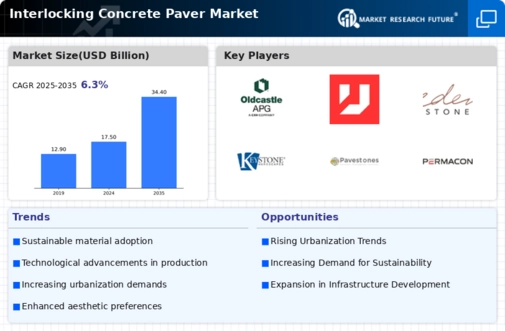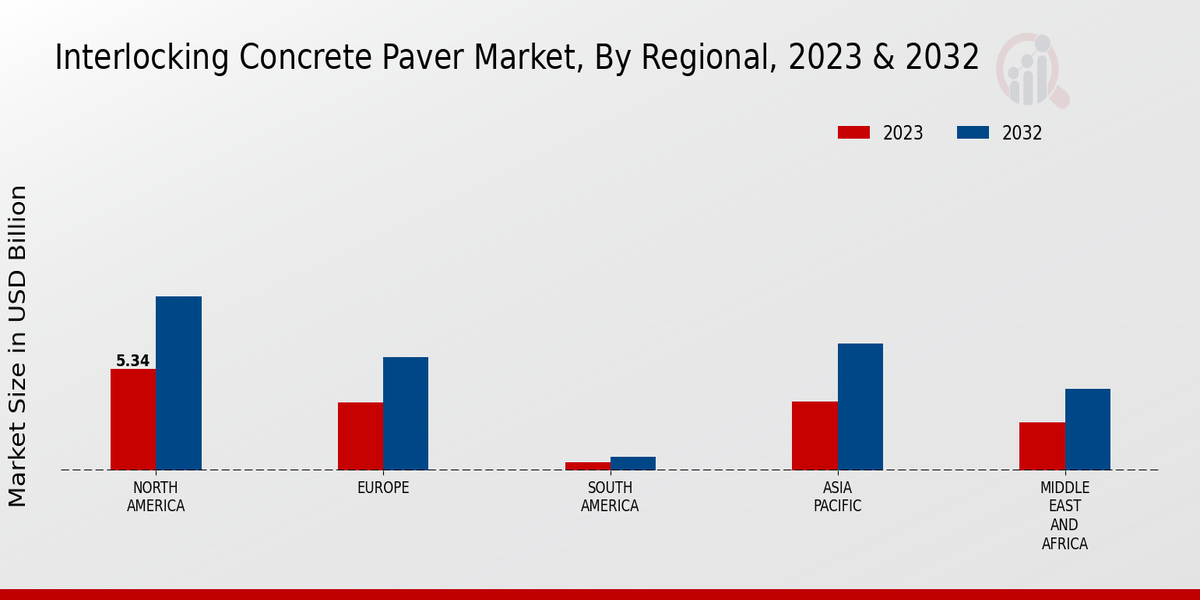Rising Urbanization
The Global Interlocking Concrete Paver Market Industry is experiencing growth driven by rapid urbanization. As cities expand, the demand for durable and aesthetically pleasing paving solutions increases. Urban areas require efficient infrastructure, and interlocking concrete pavers provide a practical solution for roads, sidewalks, and public spaces. The projected market value of 17.5 USD Billion in 2024 reflects this trend, as urban planners and developers increasingly opt for interlocking pavers due to their versatility and ease of installation. This trend is expected to continue, with urbanization rates influencing the demand for high-quality paving materials.
Market Growth Projections
The Global Interlocking Concrete Paver Market Industry is projected to experience substantial growth, with estimates indicating a market value of 17.5 USD Billion in 2024 and a potential increase to 34.4 USD Billion by 2035. This growth trajectory suggests a robust demand for interlocking concrete pavers, driven by various factors such as urbanization, sustainability, and infrastructure development. The expected CAGR of 6.34% from 2025 to 2035 further underscores the market's resilience and adaptability to changing consumer preferences and industry trends. Charts illustrating these projections highlight the positive outlook for the interlocking concrete paver market in the coming years.
Infrastructure Development
Infrastructure development is a significant driver for the Global Interlocking Concrete Paver Market Industry. Governments worldwide are investing in transportation and public works projects, which often require durable paving solutions. Interlocking concrete pavers are favored for their strength and longevity, making them ideal for roads, parking lots, and pedestrian pathways. The ongoing global emphasis on enhancing infrastructure is likely to sustain demand for these products. As urban areas expand and new projects emerge, the market is poised for growth, with the value expected to reach 17.5 USD Billion in 2024, highlighting the critical role of interlocking pavers in modern infrastructure.
Sustainability Initiatives
Sustainability is becoming a focal point in construction and landscaping, significantly impacting the Global Interlocking Concrete Paver Market Industry. Interlocking concrete pavers are often made from recycled materials and can contribute to sustainable drainage systems. This aligns with global efforts to reduce environmental footprints. As governments and organizations prioritize eco-friendly practices, the demand for sustainable paving solutions is likely to rise. The anticipated growth of the market to 34.4 USD Billion by 2035 indicates a shift towards environmentally responsible construction materials, with interlocking pavers playing a crucial role in sustainable urban development.
Technological Advancements
Technological innovations in manufacturing processes are enhancing the quality and performance of interlocking concrete pavers, thereby driving the Global Interlocking Concrete Paver Market Industry. Advances such as improved mixing techniques and automated production lines lead to higher durability and better aesthetic options. These innovations allow for the creation of pavers that can withstand extreme weather conditions and heavy loads, making them suitable for various applications. As the market evolves, the integration of technology is expected to attract more consumers, contributing to a projected CAGR of 6.34% from 2025 to 2035, reflecting the industry's adaptability to changing consumer preferences.
Aesthetic Appeal and Customization
The aesthetic appeal and customization options offered by interlocking concrete pavers are driving factors in the Global Interlocking Concrete Paver Market Industry. Consumers increasingly seek unique designs and colors for their outdoor spaces, and interlocking pavers provide a versatile solution. The ability to create intricate patterns and designs enhances the visual appeal of residential and commercial properties. This trend is likely to contribute to the market's growth, as more homeowners and businesses invest in landscaping and outdoor renovations. The anticipated growth to 34.4 USD Billion by 2035 suggests that aesthetic considerations will continue to influence purchasing decisions in the paving sector.














